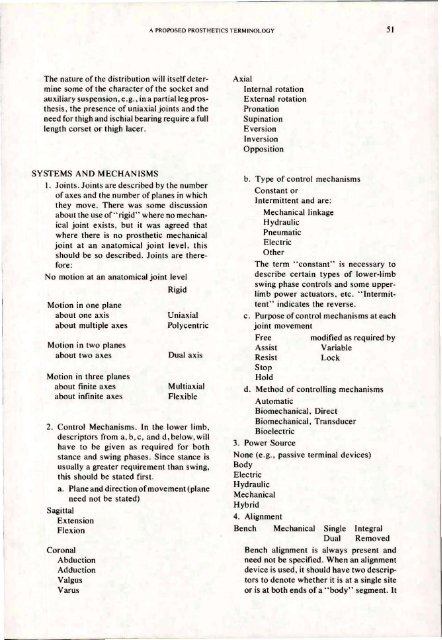Orthotics and Prosthetics
Orthotics and Prosthetics
Orthotics and Prosthetics
You also want an ePaper? Increase the reach of your titles
YUMPU automatically turns print PDFs into web optimized ePapers that Google loves.
The nature of the distribution will itself determine<br />
some of the character of the socket <strong>and</strong><br />
auxiliary suspension, e.g., in a partial leg prosthesis,<br />
the presence of uniaxial joints <strong>and</strong> the<br />
need for thigh <strong>and</strong> ischial bearing require a full<br />
length corset or thigh lacer.<br />
Axial<br />
Internal rotation<br />
External rotation<br />
Pronation<br />
Supination<br />
Eversion<br />
Inversion<br />
Opposition<br />
SYSTEMS AND MECHANISMS<br />
1. Joints. Joints are described by the number<br />
of axes <strong>and</strong> the number of planes in which<br />
they move. There was some discussion<br />
about the use of "rigid" where no mechanical<br />
joint exists, but it was agreed that<br />
where there is no prosthetic mechanical<br />
joint at an anatomical joint level, this<br />
should be so described. Joints are therefore:<br />
No motion at an anatomical joint level<br />
Motion in one plane<br />
about one axis<br />
about multiple axes<br />
Motion in two planes<br />
about two axes<br />
Motion in three planes<br />
about finite axes<br />
about infinite axes<br />
Rigid<br />
Uniaxial<br />
Polycentric<br />
Dual axis<br />
Multiaxial<br />
Flexible<br />
2. Control Mechanisms. In the lower limb,<br />
descriptors from a,b,c, <strong>and</strong> d, below, will<br />
have to be given as required for both<br />
stance <strong>and</strong> swing phases. Since stance is<br />
usually a greater requirement than swing,<br />
this should be stated first.<br />
a. Plane <strong>and</strong> direction of movement (plane<br />
need not be stated)<br />
Sagittal<br />
Extension<br />
Flexion<br />
Coronal<br />
Abduction<br />
Adduction<br />
Valgus<br />
Varus<br />
b. Type of control mechanisms<br />
Constant or<br />
Intermittent <strong>and</strong> are:<br />
Mechanical linkage<br />
Hydraulic<br />
Pneumatic<br />
Electric<br />
Other<br />
The term "constant" is necessary to<br />
describe certain types of lower-limb<br />
swing phase controls <strong>and</strong> some upperlimb<br />
power actuators, etc. "Intermittent"<br />
indicates the reverse.<br />
c. Purpose of control mechanisms at each<br />
joint movement<br />
Free<br />
Assist<br />
Resist<br />
Stop<br />
Hold<br />
modified as required by<br />
Variable<br />
Lock<br />
d. Method of controlling mechanisms<br />
Automatic<br />
Biomechanical, Direct<br />
Biomechanical, Transducer<br />
Bioelectric<br />
3. Power Source<br />
None (e.g., passive terminal devices)<br />
Body<br />
Electric<br />
Hydraulic<br />
Mechanical<br />
Hybrid<br />
4. Alignment<br />
Bench Mechanical Single Integral<br />
Dual Removed<br />
Bench alignment is always present <strong>and</strong><br />
need not be specified. When an alignment<br />
device is used, it should have two descriptors<br />
to denote whether it is at a single site<br />
or is at both ends of a "body" segment. It
















